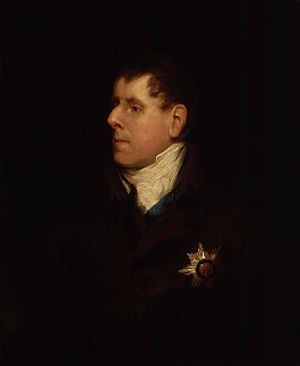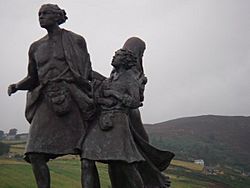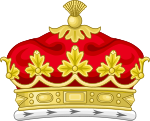Duke of Sutherland facts for kids
Quick facts for kids Dukedom of Sutherland |
|
|---|---|

Arms of Egerton, Dukes of Sutherland: Argent, a lion rampant gules between three pheons sable
|
|
| Creation date | 14 January 1833 |
| Monarch | King William IV |
| Peerage | Peerage of the United Kingdom |
| First holder | George Leveson-Gower, 2nd Marquess of Stafford |
| Present holder | Francis Egerton, 7th Duke of Sutherland |
| Heir apparent | James Granville Egerton, Marquess of Stafford |
| Remainder to | the 1st Duke's heirs male of the body lawfully begotten |
| Subsidiary titles | Marquess of Stafford Earl Gower Earl of Ellesmere Viscount Trentham Viscount Brackley Baron Gower |
| Seat(s) | Mertoun House |
| Former seat(s) | Lilleshall Hall Trentham Hall Dunrobin Castle Cliveden Stafford House |


The Duke of Sutherland is a special title in the Peerage of the United Kingdom. A "peerage" is a system of noble titles, like Duke, Earl, or Baron. This title was created in 1833 by King William IV for George Leveson-Gower.
The Leveson-Gower family became very rich because of several marriages to wealthy heiresses. This made the Dukes of Sutherland one of the richest landowning families in the United Kingdom. The title stayed in the Leveson-Gower family until 1963. After the 5th Duke passed away, the title went to the Egerton family. The current Duke is Francis Egerton, 7th Duke of Sutherland.
The Duke of Sutherland also holds other, smaller titles. These are called "subsidiary titles." They include Marquess of Stafford, Earl Gower, Earl of Ellesmere, Viscount Trentham, Viscount Brackley, and Baron Gower. These titles were created at different times and belong to different peerage systems in England and Great Britain. The Duke is also a Baronet, a title created in 1620.
Contents
A Look at the Family History
The story of the Dukes of Sutherland began with Thomas Gower. He was made a "baronet" by James I of England in 1620. This was one of the first steps towards the family gaining more important titles.
Later, a family member named John, the fifth Baronet, was given the title Baron Gower in 1706. His son, the second Baron, became an important politician. In 1746, he was made Viscount Trentham and Earl Gower.
His grandson, Granville, the second Earl, also became a well-known politician. In 1786, he was made Marquess of Stafford. His son, George, married Elizabeth Sutherland. She was the 19th Countess of Sutherland and owned huge amounts of land in Scotland.
In 1803, George also inherited a large fortune from his uncle. Because he supported an important law change called the Reform Act 1832, he was created Duke of Sutherland in 1833. This was the highest title the family achieved.
The Highland Clearances

The first Duke and Duchess of Sutherland are remembered for their part in the Highland Clearances. This was a time when many people living in the Scottish Highlands were asked to move from their homes. Their land was then used for large-scale sheep farming. This was part of a big change in farming methods in Scotland.
The main reasons for these changes were to make more money from the land and to help people avoid famines. Famines were times when there wasn't enough food, and they were a problem in the Highlands. The Duchess of Sutherland managed her family's large estate. She decided to change how the land was used.
The Clearances on the Sutherland estate mainly happened in the early 1800s. The family had more money after the Duke inherited a large fortune in 1803. This allowed them to make big changes. They planned for the inner parts of the estate to become large sheep farms. New villages were built along the coast for the people who had to move.
Some people moved willingly, but others did not want to leave their homes. In some areas, there were protests. The estate tried to help by offering good prices for their animals and building new homes. They also encouraged new industries like coal mining and fishing to help the moved families find work.
One event that caused a lot of discussion happened in 1814. Houses were often destroyed after people moved to stop them from being re-occupied. In one case, a house was burned, and an elderly woman may have been inside. This event caused a lot of upset and was widely reported.
Even though the estate said these changes were for the good of everyone, many people were very unhappy. The Clearances continued for several years. The estate tried to make sure people were treated fairly, but it was a very difficult time for many families.
Family Estates and Art Collection
When the first Duke of Sutherland passed away, his third son, Lord Francis Leveson-Gower, inherited some of the family's estates. He changed his last name to Egerton. In 1846, he was given the titles Viscount Brackley and Earl of Ellesmere.
The second Duke of Sutherland also inherited his mother's old Scottish titles, Earl of Sutherland and Lord Strathnaver. The third Duke's grandson, the fifth Duke, inherited the title in 1913.
During the First World War, the fifth Duke decided to sell much of the family's land and property. He wanted to live closer to London. He sold most of his family's Staffordshire estate. Since he had no children, the main line of the family ended when he died in 1963.
The Scottish titles (Earl of Sutherland and Lord Strathnaver) could be passed to females. So, his niece, Elizabeth, inherited them. However, the Dukedom of Sutherland and other titles could only go to male heirs. So, these titles went to his distant cousin, John Sutherland Egerton, who was already the 5th Earl of Ellesmere. He became the 6th Duke of Sutherland.
Today, much of the Duke's wealth comes from a famous art collection. This collection was put together by the first Duke's uncle. It includes amazing paintings by famous artists like Titian, Rembrandt, Raphael, and Nicolas Poussin. Some of these artworks have been sold to national galleries, but the Duke still owns many masterpieces.
Other Important Family Members
Many members of the Gower and Leveson-Gower families have been important figures. Some served as Members of Parliament (MPs), which means they were elected to help make laws for the country. Others served in the Royal Navy, like Admiral John Leveson-Gower.
One notable family member was Henry 'Shrimp' Leveson-Gower. He was a famous cricketer who captained the England team in the early 1900s. He also helped choose players for the England team.
Family Homes
The family has lived in many grand homes over the centuries. Their first main home was Lilleshall Hall. Later, they lived in very large houses like Trentham Hall, Dunrobin Castle, and Cliveden. The traditional burial place for the Dukes of Sutherland from the Leveson-Gower family was Trentham Mausoleum.
In London, the family's home was Stafford House. It was considered one of the most valuable private homes in the city.
Today, the Duke's main home is Mertoun House in St. Boswells, Scotland.
Family Coat of Arms
A coat of arms is a special design that represents a family or a noble title. When the Leveson-Gower family held the Dukedom of Sutherland, their coat of arms had specific designs, including a wolf.
Since 1963, when the Dukedom passed to the Egerton family, they have used the Egerton family coat of arms. This design features a red lion on a silver shield, with three black spearheads. The coat of arms also includes a special crest, a coronet (a small crown for a Duke), and supporters (animals that hold up the shield). The family motto is Sic Donec, which means "Thus until" in Latin.
Baronets, Barons, Earls, Marquesses, and Dukes
This section lists the people who held the main titles that led to the Dukedom of Sutherland.
Gower, later Leveson-Gower Baronets, of Stittenham (1620)
- Sir Thomas Gower, 1st Baronet (1584–c. 1665)
- Sir Thomas Gower, 2nd Baronet (c. 1605–1672)
- Thomas Gower, 3rd Baronet (c. 1666–1689)
- Sir William Leveson-Gower, 4th Baronet (c. 1647–1691)
- John Leveson-Gower, 5th Baronet (1675–1709) (became Baron Gower in 1703)
Barons Gower (1703)
- John Leveson-Gower, 1st Baron Gower (1675–1709)
- John Leveson-Gower, 2nd Baron Gower (1694–1754) (became Earl Gower in 1746)
Earls Gower (1746)
- John Leveson-Gower, 1st Earl Gower (1694–1754)
- Granville Leveson-Gower, 2nd Earl Gower (1721–1803) (became Marquess of Stafford in 1786)
Marquesses of Stafford (1786)
- Granville Leveson-Gower, 1st Marquess of Stafford (1721–1803)
- George Leveson-Gower, 2nd Marquess of Stafford (1758–1833) (became Duke of Sutherland in 1833)
Dukes of Sutherland (1833)
- George Granville Leveson-Gower, 1st Duke of Sutherland (1758–1833)
- George Granville Sutherland-Leveson-Gower, 2nd Duke of Sutherland (1786–1861)
- George Granville Sutherland-Leveson-Gower, 3rd Duke of Sutherland (1828–1892)
- Cromartie Sutherland-Leveson-Gower, 4th Duke of Sutherland (1851–1913)
- George Granville Sutherland-Leveson-Gower, 5th Duke of Sutherland (1888–1963)
- John Sutherland Egerton, 6th Duke of Sutherland (1915–2000)
- Francis Ronald Egerton, 7th Duke of Sutherland (born 1940)
Who is Next in Line?
The person who will inherit the title next is called the "Heir apparent."
- James Granville Egerton, Marquess of Stafford (born 1975), is the eldest son of the current Duke.
The second person in line is Lord Henry Alexander Egerton (born 1977), the younger son of the 7th Duke.
See also
- Earl of Sutherland
- Duke of Bridgewater
- Earl Granville
- Earl of Ellesmere
- Highland Clearances
- Sutherland


